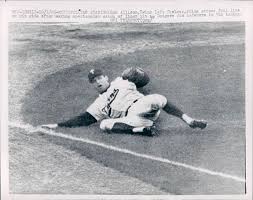 Bob Allison goes into a slide after catching Jim Lefebvre's sinking liner in the fifth inning of Game 2.
Bob Allison goes into a slide after catching Jim Lefebvre's sinking liner in the fifth inning of Game 2. Fifty years ago today, I spent the afternoon at Metropolitan Stadium, watching Jim Kaat lead the Minnesota Twins to a 5-1 win over Sandy Koufax and the Los Angeles Dodgers in Game 2 of the World Series.
The Twins took a 2-0 lead in the Series that day. Kaat went the distance, drove in two runs, and Bob Allison made a sliding, game-saving catch near the left-field line to thwart the biggest threat to a Minnesota victory.
It was a magical day that fueled a young fan’s fascination with baseball. Beating Koufax that day proved to be even more remarkable after the Twins failed to score another run in two games against the game’s best pitcher.
After knocking out Don Drysdale in Game 1 with a six-run third inning and topping Koufax in the second game, the Twins headed for Los Angeles, where they lost three games to fall behind 3-2 in the Series. They were blanked by Claude Osteen in Game 3 and Koufax in Game 5.
The two clubs returned to the Met, where Mudcat Grant pitched (and hit) the Twins to victory in Game 6, working nine innings and drilling a two-run homer off Dodgers reliever Howie Reed. But Koufax shut out the Twins again in Game 7, limiting them to three hits.
After the Twins had been shut out just three times during the regular season, they were blanked three times in October by the pitching-rich Dodgers. Perhaps it shouldn’t have been a surprise that the Dodgers quieted the dangerous Twins lineup.
Los Angeles pitching had been remarkable in the weeks leading up to the World Series. The Dodgers overtook the front-running San Francisco Giants in the National League race with a 15-1 finish. The staff allowed just 17 runs in those 16 games—good for a 0.85 ERA—and tossed eight shutouts.
For good measure, those three World Series shutouts gave the Dodgers staff a total of 11 scoreless outings in the club’s final 23 games.
The Twins took a 2-0 lead in the Series that day. Kaat went the distance, drove in two runs, and Bob Allison made a sliding, game-saving catch near the left-field line to thwart the biggest threat to a Minnesota victory.
It was a magical day that fueled a young fan’s fascination with baseball. Beating Koufax that day proved to be even more remarkable after the Twins failed to score another run in two games against the game’s best pitcher.
After knocking out Don Drysdale in Game 1 with a six-run third inning and topping Koufax in the second game, the Twins headed for Los Angeles, where they lost three games to fall behind 3-2 in the Series. They were blanked by Claude Osteen in Game 3 and Koufax in Game 5.
The two clubs returned to the Met, where Mudcat Grant pitched (and hit) the Twins to victory in Game 6, working nine innings and drilling a two-run homer off Dodgers reliever Howie Reed. But Koufax shut out the Twins again in Game 7, limiting them to three hits.
After the Twins had been shut out just three times during the regular season, they were blanked three times in October by the pitching-rich Dodgers. Perhaps it shouldn’t have been a surprise that the Dodgers quieted the dangerous Twins lineup.
Los Angeles pitching had been remarkable in the weeks leading up to the World Series. The Dodgers overtook the front-running San Francisco Giants in the National League race with a 15-1 finish. The staff allowed just 17 runs in those 16 games—good for a 0.85 ERA—and tossed eight shutouts.
For good measure, those three World Series shutouts gave the Dodgers staff a total of 11 scoreless outings in the club’s final 23 games.
 RSS Feed
RSS Feed
